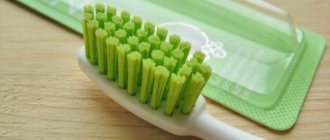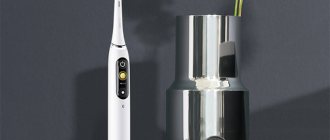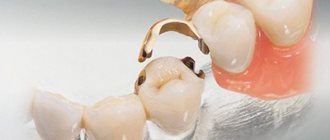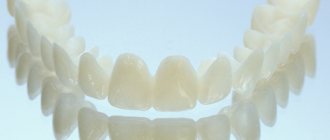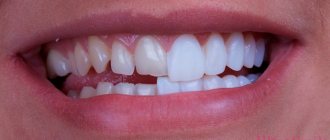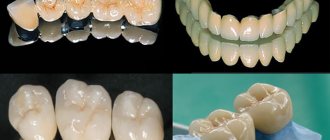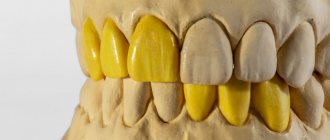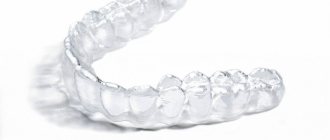January 10, 2018
Dental crowns today are one of the most common methods of prosthetics. They are installed when the upper part of the tooth is destroyed by more than half, the aesthetics are compromised, stains, chips are present, there are gaps in the row or the tooth is in an incorrect position. Another indication is the absence of one or many teeth, but in this case the crowns are part of other prostheses, for example, bridges or removable ones, or are fixed on implants.
Dental crown
Modern crowns are created from a variety of materials, and each type of prosthesis has differences in terms of cost, durability and aesthetics. UltraSmile.ru portal have prepared an overview of the most popular types of modern crowns, as well as useful recommendations that will help you not make a mistake in your choice.
Metal composite crowns
Such prostheses are created from metal alloys and covered with a composite material on top. Their main advantages are low cost, good aesthetics, and fairly high strength. The service life with careful care is no more than 5 years, but in case of minor chips and damage, the crowns can be restored directly in the oral cavity at a doctor’s appointment. The price of crowns made of metal composite is from 2,500 rubles.
Metal composite crowns
It is better to use them on the lateral teeth, because the composite may become dull over time and will need to be polished. In addition, the material is susceptible to coloring pigments from food. Also, abrasion of the composite can expose metal, which in its pure form does not look very nice and forms a blue edge in the gum area.
On a note!
Metal composite is most often used as temporary prosthetics. This option is especially suitable for dental implantation with immediate loading, since it is light and flexible.
Indications and contraindications
Coated metal dentures are installed to recreate the anatomical shape of chewing molars. Also indications for prosthetics are:
- Prevention of pathological tooth abrasion.
- Improved fixation of removable structures.
- Various damage to the crowns of teeth that cannot be restored.
- The absence of one or more units of the dentition.
- Replacement of previously installed prostheses.
- The presence of various defects.
Causes of pain under the crown
A tooth under a denture can hurt both due to unprofessional work of the dentist, and due to a piece of instrument getting into the canal.
In addition, metal structures are installed as supporting teeth when installing bridge structures.
Contraindications to the installation of sprayed dentures are:
- Presence of cancer .
- abnormalities .
- In case of defect of the entire dentition.
- disease .
- Periodontal disease and periodontitis, occurring in severe form.
- Increased wear of molars.
Also, metal structures with coating are not installed in the presence of osteoporosis or osteomyelitis of the jaw bone tissue.
Ceramic composite crowns
Such crowns have excellent external characteristics, since they are created from a material that includes both ceramics and composite. They are hypoallergenic and do not cause irritation to the mucous membrane. A chipped composite can be easily adjusted right in the dental chair. Dentures will last up to 10 years.
Ceramic composite crowns
Crowns are less durable than metal-ceramics. Well suited for restoring teeth in the smile area. It is also an excellent option for implant-supported dentures. True, to acquire a “highly aesthetic” smile you will have to pay accordingly. Their price starts from 7,000 rubles.
Punching technique
Dentures differ in the type of material and manufacturing method. Manufacturing technology using the stamping method implies:
- taking an impression;
- tapping the required shape of the structure on a standard workpiece.
The stamped model is an affordable method of prosthetics. Products are created on the basis of blanks and adjusted in accordance with the individual anatomical specifics of the patient.
The structures are strong, but the natural teeth underneath them are quickly destroyed.
Metal-ceramic crowns
There are two options for prostheses: some are a durable metal frame made of inexpensive alloys, others are made of noble metals. In this case, both are covered with a thin layer of ceramics, which is baked in an oven. Metal-ceramic “teeth” are very durable, can withstand heavy chewing loads, and will last 10 years or more. In addition, this will be the best option for restoring teeth in terms of price and quality - you can spend 5-6,000 rubles. But the average cost in Moscow is from 7-10,000 rubles.
Metal-ceramic crowns based on gold
Another option is shoulder crowns. They have a ceramic coating applied not only to the top, but also to the base itself. Thanks to this, the gums do not come into contact with the metal, a loose fit of the prosthesis to the tooth is eliminated, the formation of allergic reactions is minimal and the oxidation of the metal from contact with saliva is minimized - as a result, darkening of the gums is avoided.
Structure
Metal structures with spraying are a one-piece construction. Previously, they were made according to an established pattern, and already in the dental office the doctor gave it the desired shape. But this method has not been used for a long time, and the prosthesis is made according to individual casts.
Sprayed crowns are solid structures that are installed when one or more teeth are lost.
Dentures allow you to recreate the anatomical shape of chewing molars and eliminate various defects. Installation takes place in three stages - preparation, preparation, fixation.
With proper care, products do not lose their functions for a long time.
The advantage of the design is the variety of choices. Depending on the patient’s wishes, it can be made with lining, with or without coating.
When creating bridges, the crowns are not soldered together, but are made up of solid rows. Thus, there is no gap between the artificial teeth, and bacteria cannot penetrate there.
First of all, the surface of the prosthesis is degreased and polished. The structure is then coated with a white substance called titanium nitride using vacuum plasma technology. Spraying is applied at high temperature using electric current.
It may seem that crowns made of pure gold are more functional.
However, it is not for nothing that dental technicians choose coated metal. The fact is that pure gold is too soft and quickly deforms under the pressure of opposing teeth.Budget alternative: silver or palladium plating.
Dentist
Novikova Olga Alexandrovna
8 years of experience
All-ceramic crowns
On a note!
Crowns are universal in use and can be fixed both on the remaining parts of a living tooth and on a tooth without a nerve, on a pin or stump inlay.
In all cases, they completely recreate the anatomy of the tooth, its aesthetics and allow you to return full functionality. Dental ceramics are less durable than metal ceramics, but they look much more aesthetically pleasing. The translucency of the ceramic base allows for ideal restoration of the front teeth. However, due to their fragility, the service life of the prostheses will be from 5 to 7 years.
All-ceramic crowns
Today there are also pressed ceramics, which are much more durable than ordinary ones. Such dentures look even better and last many times longer. The price of all-ceramic crowns starts from 8,000 rubles and can reach 20,000 rubles if pressed ceramics are used.
Price issue
The products have an optimal ratio of quality and price. The last criterion is mainly determined by the material used for spraying.
The table below shows approximate prices per unit, taking into account the type of spraying:
| Spray material | Approximate cost, thousand rubles. |
| Gold | from 16 |
| Zirconium | from 12 |
| Plastic | from 4 |
| Ceramics | from 10 |
| Silver | from 8 |
Zirconium crowns
This option is suitable for those who value the highest aesthetics, maximum strength, high wear resistance and durability. Such dentures are not created manually, but using milling and computer technology of the latest generation, therefore they repeat the structure with the highest accuracy and are also precisely positioned on the tooth. In addition, zirconium is completely compatible in its characteristics with the human body, has light transmission like natural teeth and is almost indistinguishable from the natural shade of enamel.
Zirconia crowns
Of course, you will have to pay many times more for zirconium dioxide crowns than for other prostheses - at least 12,000 rubles apiece, but they will justify their cost and will last about 20 years.
When choosing dental crowns, you should pay attention not only to the price, but also to other characteristics of the prostheses, to the appropriateness of their use for a certain clinical picture. Then the choice will be correct and will meet the main expectation from going to the dentist - getting a beautiful and functional smile.
Solid models
Manufactured using the one-piece casting method, i.e. mold pouring technique. It's inexpensive, simple and fast, because... No time is wasted on soldering crowns. But the most important difference, and naturally an advantage over the previous method, is a longer period of operation - at least 15 years.
Solid crowns are made only individually based on impressions of the patient’s treated teeth.
In addition, with this approach to manufacturing:
- it is possible to achieve an ideal fit to the gum tissue;
- only a homogeneous alloy of material is taken;
- it is possible to restore the chewing group of teeth;
- obtain sufficient strength and high wear resistance;
- reduce the layer of teeth grinding to a minimum.
The manufacturing process involves performing the following manipulations:
- Tooth preparation.
- Taking an impression with silicone mass.
- Fixation of the central relationship of the jaw arches.
- Fitting the crown, checking the occlusal relationship.
- Creation of a collapsible plaster model;
- Modeling a wax sample.
- Replacing wax with metal.
- Pouring metal into the prepared mold.
- Cooling of the material and subsequent removal from the mold.
- Technical processing of the structure.
- Finishing: grinding and polishing.
Important! The dentist decides which product based on the manufacturing method is suitable for recreating teeth based on an examination. An important factor when selecting the type of design is the client’s budget.
Let's figure out whether it is possible to put a crown on a living tooth, and in what cases this method is justified.
Come here if you haven’t decided yet which crowns are best for implants.
At this address https://zubovv.ru/protezirovanie/nesemnyie-p/koronki-np/sposobyi-pochinki-skola-keramiki.html we will consider materials that can be used to repair ceramic chips on the crown.
Watch the video: Types of dental crowns
Notice
: Undefined variable: post_id in
/home/c/ch75405/public_html/wp-content/themes/UltraSmile/single-item.php
on line
45 Notice
: Undefined variable: full in
/home/c/ch75405/public_html/wp-content /themes/UltraSmile/single-item.php
on line
46
Rate this article:
( 2 ratings, average: 3.00 out of 5)
dental restoration
Comments
[…] oral cavity only as part of dentures: inlays, crowns, fillings, as well as implants. Metals react [...]
Galvanic syndrome or electric current in the mouth. What to do? (09/01/2018 at 09:02) Reply to comment
[…] for example, they compare favorably with metal and metal-ceramic products precisely from the point of view […]
Methods for making ceramic dentures. How are ceramic dentures made? (09/03/2018 at 09:00) Reply to comment
[…] bridge, this method does not involve installing crowns on the supporting teeth, and therefore is called gentle. They highlight […]
Methods of prosthetics without grinding teeth, descriptions, advantages and disadvantages (09/03/2018 at 09:03) Reply to comment
Write your comment Cancel reply
Design Features
A special layer is necessarily applied to metal crowns - spraying, which improves their appearance, and in some cases has a positive effect on strength and wear.
The table below describes the main pros and cons of spray coating materials.
| Type of prosthesis | Advantages | Minuses |
| Coated with base metals | Affordable price, quick and easy production, installation, low maintenance requirements. | Possibility of allergies or galvanic reactions due to incompatible materials. |
| Coated with precious metal | Acceptable aesthetics, absence of allergies, metallic taste, galvanic effect. | Expensive. |
| Coated with plastic. | Presentable appearance, affordable price. | The likelihood of cracks and chips due to poor compatibility of the metal frame and cladding. |
| Porcelain coated | Maximum aesthetics at an affordable price. | Chips and microcracks may form. |
| Gold plating | The material is identical in erasing speed to natural enamel, hygienic, durable, hypoallergenic, and has an antiseptic effect. | The ratio of cost and aesthetics does not live up to expectations. |
Stock
-47%
Dental implant Osstem 35,000 rub.
18500 rub.
get -20 %
Manufacturing of removable denture Acry Free 40,000 rub.
32,000 rub.
get -47 %
Dental implantation RUB 18,500.
until 01/15/2022 35,000 rub. 18500 rub.
get -10 %
Premium implantation Nobel and zirconium dioxide crown 150,000 rub.
135,000 rub. get
Reviews
Whenever it comes to prosthetics using crowns, a person faces the same dilemma - which material is better for the products.
With the rapid development of technological processes and the emergence of high-quality materials, metal crowns with various types of coating continue to be in demand.
You can talk about your experience with prosthetics using these structures, or express an opinion regarding the advisability of their use in dentistry, by leaving a comment on this article.
If you find an error, please select a piece of text and press Ctrl+Enter.
Tags dental crowns fixed dentures
Did you like the article? stay tuned
